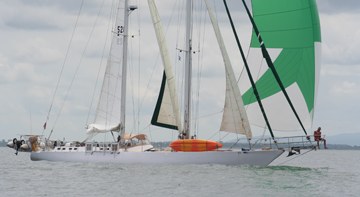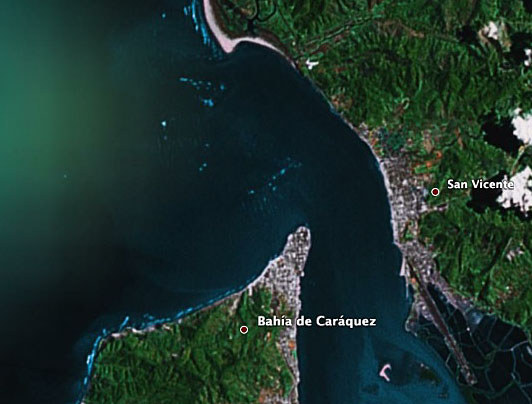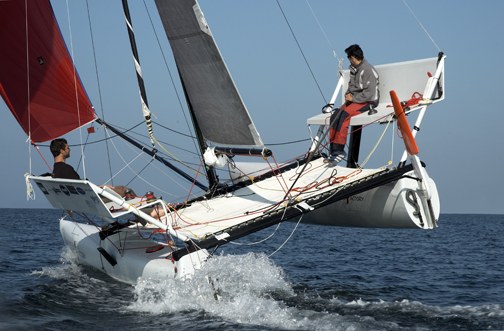
Joyon Smashes 24-Hour Solo Record
"It seemed unavoidable, and indeed it has happened," writes Javier de Muns, Latitude‘s man in Brittany. "Francis Joyon, racing around the world singlehanded aboard his 97-ft trimaran IDEC has set a new 24-hour solo record of 616 nautical miles — an average of 25.6 knots."
And it’s not it’s not like he’s doing it in lovely conditions. The outside temperature deep in the Indian Ocean is 33 degrees, and because IDEC is not equipped with a heater, it’s never more than 41 degrees inside the cabin. Joyon wears three layers of "polar wear" to keep from dying of exposure.
The previous 24-hour record was 610 miles, and was set by Yvan Bourgnon with the 60-ft ORMA trimaran Brossard in August of ’06.
Javier reports that it hadn’t been Joyon’s intention to try for a 24-hour record, "but as the weather conditions forced me, I said to myself, ‘Let’s do it.’" Following the advice of his weather router, Jean-Yves Bernot, Joyon pushed IDEC to prevent a low from catching up with him. It was sailing in 25 to 30 knots of wind, in relatively flat seas in front of the low, that allowed him to set the new record. Joyon and Bernot believe that similar conditions will last for at least 24 more hours, after which an area of lighter winds will slow his progress.
Just 19 days into his record attempt, Joyon is already nearly 2,000 miles ahead of Ellen MacArthur’s pace when she established the current solo around the world record of 71 days and 14 hours.
Is there anyone else out there who finds this record attempt as compelling as we do?
Ecuador Makes it Hard for Cruisers

©2007 Latitude 38 Media, LLC
"We’re finally on a mooring here in Bahia de Caraquez, but it wasn’t easy getting here," reports Greg King from aboard Jennifer Sander’s Long Beach-based 64-ft staysail schooner Cocokai. "We — including Jennifer’s daughter Coco, and Ducky — waited two weeks for the port pilot to return to Bahia de Caraquez to escort us in, as they will no longer allow boats to enter on their own. After the pilot was delayed even longer, we were given a set of waypoints and special permission to enter on our own. I thought no problemo, and told them I didn’t even need an escort.
"Due to unusually light winds, we were running about 15 minutes behind schedule, and had to motorsail the last 10 miles to catch the incoming tide. If you get stuck, you don’t want it to be on an outgoing tide for obvious reason. Anyway, the waypoints were for exiting Bahia, so I had to reverse them coming in. I had everything right in my head — except for which side of the lighthouse to pass on! You’re supposed to head straight to the beach, then make a hard left 50 yards or so off the beach. But when I got close to the beach and turned to pass inside of the lighthouse, there was no more than 10 feet between it and the rocks — so something was wrong.
"I yelled to Jen that there was no way we could fit between it and the rocks! I quickly stopped the boat — well, as quickly as a 30-ton boat can be stopped — at which point she quickly realized I hadn’t reversed my thinking about which side of the lighthouse to pass on. Unfortunately, in those few frantic seconds, with the current running about five knots, we had drifted many yards inside of the waypoints. The depthsounder was reading in the low 5s — add 2 feet for the transducer under the hull — so I quickly got us going 90 degrees to get back on course. At one point, when the boat rolled in the churned up waves, I saw the depth at 4.4 feet — and Cocokai draws 6.6 feet with the board up! Fortunately, I didn’t feel any bumps.
"I soon got back on track and Tripp Martin, our agent, was on the radio saying I just got past the toughest part. I was relieved. It turns out there was a cheering section on the beach taking photos to see if we would make it or not.
"Lesson learned — Don’t always send the girls to the bow to keep them out of your way. A guy must focus! Plus, two heads are better than one!

© Latitude 38 Media, LLC
"Check out the entrance to the bay at S 00’35.681 W 080’25.571. In the Google Earth photo, you can probably see all the shallows and bars that plague the entrance. When we came in at high tide, all we could see was water."
Waiting two weeks for a pilot? Oh boy, the officialdom bugs seem to have gotten a good grasp on things in Ecuador.
Beach Cat Crosses Atlantic in 12 Days
There’s no denying that the French are showing the world the way when it comes to ballsy ocean sailing. The day before Francis Joyon set the new 24-hour record with Idec, Benoit Lequin, 33, and Pierre-Yves Moreau, 35, two other Frenchmen, established a new transatlantic record for a . . . beach cat.

The very experienced duo sailed their 20-ft cat 2,700 miles from Dakar, Senegal, to Pointe-a-Pitre, Guadeloupe, in just 11 days and 11 hours, breaking the old record by more than two days.
For sake of comparison, the first three boats to finish the 2,700 miles Atlantic Rally for Cruisers, from the Canary Islands to St. Lucia, were the Matelot, a Southern Wind 80, which took 12 days, 15 hours; AAG Big One, a Volvo 70 that took 12 days, 13 hours; and Venemous, a Swan 86 that took 12 days, 13 hours.
Incroyable, no?
